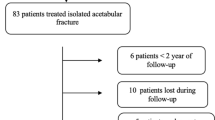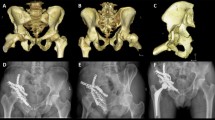Abstract
Purpose
The aim was to assess acetabular fracture outcomes of percutaneous fixation (PF) with or without minimally invasive surgery (MIS).
Methods
Between July 2011 and October 2016, acetabular fractures fixed with PF with or without MIS were included. Data collected are demographics, mechanism of injury, associated injuries, time to surgery, American Society of Anesthesiologists grade, fracture characteristics, surgical techniques, fracture reduction, secondary osteoarthritis (OA), revision surgery, patient survival and complications.
Results
Of 26 patients with a mean age of 56 years (19–86) (22 males and 4 females), 11 were < 50 years age (U50) and 15 were > 50 years (A50). Most common pattern was anterior column with posterior hemi-transverse. Three out of 11 U50 were minimally displaced and had PF only; the rest had MIS and PF. All had good fracture reduction, but 2 had secondary OA at follow-up but no further surgery. Eight out of 26 had secondary OA but only 3 needed surgery. Three (A50 with PF) with fair/poor reduction (deemed unfit for open reduction) had secondary OA but no further intervention. Three more (A50 with MIS + PF) had secondary OA treated with primary total hip replacement (THR). Complications were as follows: one foot drop recovered after immediate repositioning of screw, one cardiac event and one pulmonary embolism.
Conclusion
Fracture mal-reduction predicts secondary OA, but good fracture reduction does not prevent secondary OA. MIS and PF in elderly are useful even with suboptimal reduction as it sets the bed for a non-complex THR. Despite MIS surgery, medical complications are potentially significant.





Similar content being viewed by others
References
Judet R, Judet J, Letournel E (1964) Fractures of the acetabulum: classification and surgical approaches for open reduction. Preliminary report. J Bone Joint Surg Am 46:1615–1646
Daurka JS, Pastides PS, Lewis A, Rickman M, Bircher MD (2014) Acetabular fractures in patients aged > 55 years: a systematic review of the literature. Bone Joint J 96(2):157–163
Laird A, Keating JFJ (2005) Acetabular fractures: a 16-year prospective epidemiological study. Bone Joint Surg Br 87(7):969–973
Briffa N, Pearce R, Hill AM, Bircher M (2011) Outcomes of acetabular fracture fixation with ten years’ follow-up. J Bone Joint Surg Br 93:229–236
Dailey SK, Archdeacon MT (2014) Open reduction and internal fixation of acetabulum fractures: does timing of surgery affect blood loss and OR time? J Orthop Trauma 28:497–501
Magnussen RA, Tressler MA, Obremskey WT, Kregor PJ (2007) Predicting blood loss in isolated pelvic and acetabular high-energy trauma. J Orthop Trauma 21:603–607
Lin YC, Chen CH, Huang HT et al (2008) Percutaneous antegrade screwing for anterior column fracture of acetabulum with fluoroscopic-based computerized navigation. Arch Orthop Trauma Surg 128:223–226
Ochs BG, Stuby FM, Ateschrang A, Stoeckle U, Gonser CE (2014) Retrograde lag screw placement in anterior acetabular column with regard to the anterior pelvic plane and midsagittal plane - virtual mapping of 260 three-dimensional hemipelvises for quantitative anatomic analysis. Injury 45:1590–1598
Mears DC (1999) Surgical treatment of acetabular fractures in elderly patients with osteoporotic bone. J Am Acad Orthop Surg 7:128–141
Karunakar MA, Shah SN, Jerabek S (2005) Body mass index as a predictor of complications after operative treatment of acetabular fractures. J Bone Joint Surg 87:1498e502
Sems SA, Johnson M, Cole PA, Byrd CT, Templeman DC (2010) Minnesota orthopaedic trauma group elevated body mass index increases early complications of surgical treatment of pelvic ring injuries. J Orthop Trauma 24:309–314
Gary JL, VanHal M, Gibbons SD, Reinert CM, Starr AJ (2012) Functional outcomes in elderly patients with acetabular fractures treated with minimally invasive reduction and percutaneous fixation. J Orthop Trauma 25(5):278–283
Letournel E (2007) Acetabulum fractures: classification and management. Orthop Trauma Dir 5(05):27–33
Caviglia H, Mejail A, Landro ME, Vatani N (2018) Percutaneous fixation of acetabular fractures. EFORT Open Rev 3(5):326–334
Helfet DL, Schmeling GJ (1994) Management of complex acetabular fractures through single nonextensile exposures. Clin Orthop Relat Res 305:58–68
Judet R, Letournel E (1974) Les fractures du cotyle. Masson, Paris
Giannoudis PV, Grotz MRW, Papakostidis C, Dinopoulos H (2005) Operative treatment of displaced fractures of the acetabulum: a meta-analysis. J Bone Joint Surg British Vol 87(1):2–9
Baker G, McMahon SE, Warnock M et al (2020) Outcomes of conservatively managed complex acetabular fractures in the frail and elderly one year post injury. Injury. https://doi.org/10.1016/j.injury.2019.12.008
Magu NK, Rohilla R, Arora S (2012) Conservatively treated acetabular fractures: a retrospective analysis. Indian J Orthop 46(1):36
Crowl AC, Kahler DM (2002) Closed reduction and percutaneous fixation of anterior column acetabular fractures. Comput Aided Surg 7(3):169–178
Gary JL, VanHal M, Gibbons SD, Reinert CM, Starr AJ (2012) Functional outcomes in elderly patients with acetabular fractures treated with minimally invasive reduction and percutaneous fixation. J Orthop Trauma 26(5):278–283. https://doi.org/10.1097/BOT.0b013e31823836d2
Starr AJ, Jones AL, Reinert CM, Borer DS (2001) Preliminary results and complications following limited open reduction and percutaneous screw fixation of displaced fractures of the actabulum. Injury 32:45–50
Funding
No funds, grants or other supports were received. The authors declare they have no financial interests.
Author information
Authors and Affiliations
Contributions
All authors made substantial contributions to the work of the paper, confirm that the data provided are accurate and approve the final version being submitted.
Corresponding author
Ethics declarations
Conflict of interest
Nothing to disclose.
Availability of data and material
All data were used from hospital records maintaining full patient confidentiality.
Additional information
Publisher's Note
Springer Nature remains neutral with regard to jurisdictional claims in published maps and institutional affiliations.
Rights and permissions
About this article
Cite this article
Debuka, E., Kumar, G., Dalal, N. et al. Fracture characteristics and outcomes of acetabular fracture management with minimally invasive approach and percutaneous fixation. Eur J Orthop Surg Traumatol 31, 1363–1368 (2021). https://doi.org/10.1007/s00590-021-02886-5
Received:
Accepted:
Published:
Issue Date:
DOI: https://doi.org/10.1007/s00590-021-02886-5




